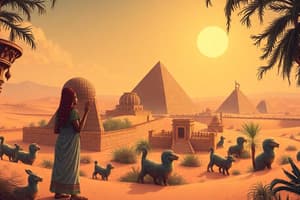Podcast
Questions and Answers
Where is the region of Nubia primarily located?
Where is the region of Nubia primarily located?
- Northeastern Africa (correct)
- Eastern Africa
- Southern Africa
- Western Africa
What is the name of the river that played a crucial role in Nubian agriculture?
What is the name of the river that played a crucial role in Nubian agriculture?
- Mediterranean Sea
- Nile River (correct)
- Red Sea
- Atbara River
During which period did the Nubian capital shift to Meroe?
During which period did the Nubian capital shift to Meroe?
- Meroitic Period (correct)
- Napatan Period
- Roman Period
- Late Period
What type of language did the Nubians speak?
What type of language did the Nubians speak?
Which deity was prominent in Nubian religion?
Which deity was prominent in Nubian religion?
What was the main source of gold in Nubia?
What was the main source of gold in Nubia?
Who was the Nubian king who conquered Egypt and became a pharaoh of the 25th dynasty?
Who was the Nubian king who conquered Egypt and became a pharaoh of the 25th dynasty?
What was the name of the legendary queen known for her diplomatic skills during the Roman period?
What was the name of the legendary queen known for her diplomatic skills during the Roman period?
Flashcards are hidden until you start studying
Study Notes
Geography and Climate
- Located in northeastern Africa, primarily in present-day northern Sudan and southern Egypt
- Nubia refers to the region between the first cataract of the Nile River and the confluence of the Nile and Atbara Rivers
- The Nubian civilization flourished in a region of savannas, deserts, and Nile River valleys
History
- The Nubian civilization emerged around 2000 BCE and lasted until the 4th century CE
- Divided into three periods:
- Napatan Period (2000 BCE - 300 BCE): Nubian kings ruled from Napata, the capital city
- Meroitic Period (300 BCE - 300 CE): The capital shifted to Meroe, and the kingdom reached its peak
- Late Period (300 CE - 400 CE): The kingdom declined, and the Nubian civilization eventually disappeared
Culture and Society
- Language: Spoke a Nilo-Saharan language, with influences from ancient Egyptian and Greek
- Religion: Worshiped a mix of Egyptian and indigenous gods, with Isis and Amun being prominent deities
- Social Hierarchy: Kings, nobles, priests, artisans, and farmers formed the social structure
- Architecture: Built numerous pyramids, temples, and tombs, often blending Egyptian and Nubian styles
Economy and Trade
- Agriculture: The Nile River and its annual flooding made agriculture possible, with crops like millet, dates, and grapes
- Trade: Exchanged goods like gold, ivory, and ostrich feathers with Egypt, Greece, and other Mediterranean regions
- Mining: Mined gold, copper, and iron ore in the Nubian Desert
Notable Figures
- Taharqa: A powerful Nubian king who conquered Egypt and became a pharaoh of the 25th dynasty
- Candace of Meroe: A legendary queen who ruled Nubia during the Roman period and was known for her diplomatic skills
Geography and Climate
- Located in northeastern Africa, spanning across northern Sudan and southern Egypt
- Nubia region lies between the first cataract of the Nile River and the confluence of the Nile and Atbara Rivers
- Civilization flourished in a region of savannas, deserts, and Nile River valleys
History
- Nubian civilization emerged around 2000 BCE and lasted until the 4th century CE
- Napatan Period (2000 BCE - 300 BCE): Nubian kings ruled from Napata, the capital city
- Meroitic Period (300 BCE - 300 CE): Capital shifted to Meroe, and the kingdom reached its peak
- Late Period (300 CE - 400 CE): Kingdom declined, and the Nubian civilization eventually disappeared
Culture and Society
- Spoke a Nilo-Saharan language with influences from ancient Egyptian and Greek
- Worshiped a mix of Egyptian and indigenous gods, with Isis and Amun being prominent deities
- Social hierarchy consisted of kings, nobles, priests, artisans, and farmers
- Architecture blended Egyptian and Nubian styles, with numerous pyramids, temples, and tombs
Economy and Trade
- Nile River and its annual flooding enabled agriculture, with crops like millet, dates, and grapes
- Exchanged goods like gold, ivory, and ostrich feathers with Egypt, Greece, and other Mediterranean regions
- Mined gold, copper, and iron ore in the Nubian Desert
Notable Figures
- Taharqa: Powerful Nubian king who conquered Egypt and became a pharaoh of the 25th dynasty
- Candace of Meroe: Legendary queen who ruled Nubia during the Roman period and was known for her diplomatic skills
Studying That Suits You
Use AI to generate personalized quizzes and flashcards to suit your learning preferences.




